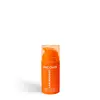What's inside
What's inside
 Key Ingredients
Key Ingredients

 Benefits
Benefits

 Concerns
Concerns

 Ingredients Side-by-side
Ingredients Side-by-side

Water
Skin ConditioningButylene Glycol
Humectant3-O-Ethyl Ascorbic Acid
Skin ConditioningGlycerin
HumectantDiethoxyethyl Succinate
SolventArbutin
AntioxidantDipropylene Glycol
HumectantGlycereth-26
HumectantMethylpropanediol
SolventPropanediol
Solvent1,2-Hexanediol
Skin ConditioningPanthenol
Skin ConditioningAmmonium Acryloyldimethyltaurate/Vp Copolymer
Chondrus Crispus Extract
Skin ConditioningPolyglyceryl-10 Laurate
Skin ConditioningSaccharum Officinarum Extract
MoisturisingGlyceryl Caprylate
EmollientSodium Citrate
BufferingXanthan Gum
EmulsifyingEthylhexylglycerin
Skin ConditioningCitric Acid
BufferingCitrus Aurantium Bergamia Fruit Oil
MaskingAllantoin
Skin ConditioningSodium Phytate
Adansonia Digitata Fruit Extract
EmollientCitrus Limon Peel Oil
MaskingBeta-Glucan
Skin ConditioningTocopherol
AntioxidantWater, Butylene Glycol, 3-O-Ethyl Ascorbic Acid, Glycerin, Diethoxyethyl Succinate, Arbutin, Dipropylene Glycol, Glycereth-26, Methylpropanediol, Propanediol, 1,2-Hexanediol, Panthenol, Ammonium Acryloyldimethyltaurate/Vp Copolymer, Chondrus Crispus Extract, Polyglyceryl-10 Laurate, Saccharum Officinarum Extract, Glyceryl Caprylate, Sodium Citrate, Xanthan Gum, Ethylhexylglycerin, Citric Acid, Citrus Aurantium Bergamia Fruit Oil, Allantoin, Sodium Phytate, Adansonia Digitata Fruit Extract, Citrus Limon Peel Oil, Beta-Glucan, Tocopherol
 Reviews
Reviews

Ingredients Explained
These ingredients are found in both products.
Ingredients higher up in an ingredient list are typically present in a larger amount.
Panthenol is a common ingredient that helps hydrate and soothe the skin. It is found naturally in our skin and hair.
There are two forms of panthenol: D and L.
D-panthenol is also known as dexpanthenol. Most cosmetics use dexpanthenol or a mixture of D and L-panthenol.
Panthenol is famous due to its ability to go deeper into the skin's layers. Using this ingredient has numerous pros (and no cons):
Like hyaluronic acid, panthenol is a humectant. Humectants are able to bind and hold large amounts of water to keep skin hydrated.
This ingredient works well for wound healing. It works by increasing tissue in the wound and helps close open wounds.
Once oxidized, panthenol converts to pantothenic acid. Panthothenic acid is found in all living cells.
This ingredient is also referred to as pro-vitamin B5.
Learn more about PanthenolTocopherol (also known as Vitamin E) is a common antioxidant used to help protect the skin from free-radicals and strengthen the skin barrier. It's also fat soluble - this means our skin is great at absorbing it.
Vitamin E also helps keep your natural skin lipids healthy. Your lipid skin barrier naturally consists of lipids, ceramides, and fatty acids. Vitamin E offers extra protection for your skin’s lipid barrier, keeping your skin healthy and nourished.
Another benefit is a bit of UV protection. Vitamin E helps reduce the damage caused by UVB rays. (It should not replace your sunscreen). Combining it with Vitamin C can decrease sunburned cells and hyperpigmentation after UV exposure.
You might have noticed Vitamin E + C often paired together. This is because it is great at stabilizing Vitamin C. Using the two together helps increase the effectiveness of both ingredients.
There are often claims that Vitamin E can reduce/prevent scarring, but these claims haven't been confirmed by scientific research.
Learn more about TocopherolWater. It's the most common cosmetic ingredient of all. You'll usually see it at the top of ingredient lists, meaning that it makes up the largest part of the product.
So why is it so popular? Water most often acts as a solvent - this means that it helps dissolve other ingredients into the formulation.
You'll also recognize water as that liquid we all need to stay alive. If you see this, drink a glass of water. Stay hydrated!
Learn more about Water